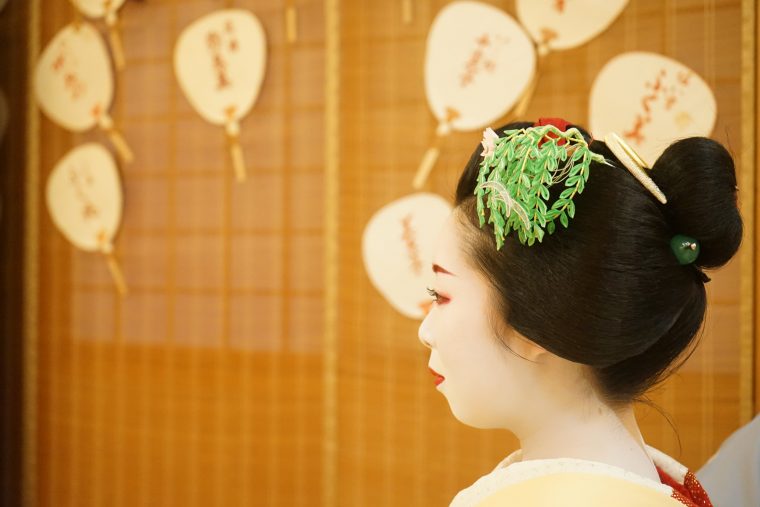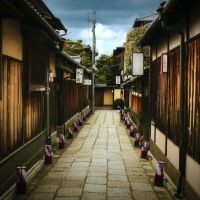Maiko And Geisha With No Makeup (Sendo-mairi)
Kanae Nakahama
Latest posts by Kanae Nakahama (see all)
- Gion and Geisha Districts in Kyoto - 2017/09/22
- Geisha Show In Kyoto - 2017/09/04
- Maiko And Geisha With No Makeup (Sendo-mairi) - 2017/07/10
Contents
Maiko And Geisha With No Makeup (Sendo-mairi)
There is a rare day you can see Maiko and Geisha with no makeup. Today I would like to introduce an event that is called, “Sendo-mairi” presented by Inoue style of Japanese dancing. It is famous that Maiko who are walking during daytime with makeup are most fake Maiko. That‘s because real Maiko have lessons; such as dancing lessons to take. The real Maiko do not walk with makeup during daytime if it isn‘t an special event. However, at this event you can meet a real Maiko and Geisha with no makeup. They are just very young cute girls if you see them without makeup.
Inoue Style Of Japanese Dancing Presenting Sendo-mairi At Yasaka Shrine
First of all, Sendo-mairi is a event that is hold every year at Yasaka Shrine in the beginning of July. It is presented by Inoue style of Japanese dancing. The Maiko and Geisha who are following Inoue style of Japanese dancing have an association called “Miyabi-kai (Miyabi association)”. About 80 people who follow Inoue style of Japanese dancing participate this event. It is an event mainly for people who work at Gion-kobu (the name of the Hanamachi in Gion). The date of the day is arranged every year. It is hold for the Maiko to pray for perfect state of health and their dancing skills to rise.
“Sendo” means 1,000 times, and “mairi” means praying in Japanese. If you just take the meaning, you might think they’re going to pray 1,000 times. However, they walk around the main temple about three times and pray (it depends at the Maiko, how many times they are going to walk around the temple). They don’t actually pray 1,000 times.
Joining Sendo-mairi
This year Sendo-mairi was hold at July 7th. In Japan, July 7th is known as Tanabata festival; an event based on a fairytale and people write a wish on a strip of paper and display it on bamboo grass. Sendo-mairi starts around 9:30am. It is a vague expression because it depends at the time when the Maiko arrives. The purification ceremony starts at 10am, so they pray before 10am to be in time.
It was my first time to join this event. I went to Yasaka Shrine around 9am, but there were already lots of people with cameras. Because of the photographers, people who didn’t even know the event stopped by curiously what the photographers were waiting for.
The first Maiko arrived around 9:20am. Maiko are living in a really strict vertical relationship society. As you can say from the photograph, the Maiko that is in front of the two Maiko is the senior Maiko. The younger Maiko can only make action after the senior Maiko.
Around 9:30am, lots of Maiko and Geisha arrived. If they don’t have the Maiko makeup, they‘re just cute young girls.
They were walking to the main building of the shrine. It was a very hot day, so almost every Maiko had a parasol.
At the main building of the shrine, they were greeting to other senior Maiko, Geisha, and to the dance teachers.
The Wooden Tag
This event starts by picking a wooden tag from the wooden box. The wooden tag was written “Chonai-anzen”, meaning safety for the neighborhood in Japanese.
Even though there were lots of people staring and taking photographs of them, they were so calmed down and didn’t look nervous at all. In fact, they looked very fun and reminded me about a school trip.
Walking Around The Main Shrine
They walked around the main shrine. In their hand there was the wooden tag. Most of the Maiko were talking, but there was a Geisha walking seriously. Maybe she was thinking deeply inside herself.
The amount of walking around the building depends to them. It is said they walk around three times. However, maybe because there were lots of people at Yasaka shrine, most of the Maiko walked around the building only once.
Time To Pray
There were lots of Maiko, waiting to pray next. Some of them prayed for a long time, hoping for their health and dancing skills to raise.
Some of them looked happy and calmed down even more after praying.
Maiko had perfectly different expressions on their faces. They were very natural. Watching them made me feel young again. It was another new personal magnetism I learned from watching them.
It was a refreshing surprise watching the Maiko to pray. The photographers were aiming for the best shots.
Waiting For The Seniors To Enter The Main Shrine
After praying, the next event was the purification ceremony. However, even though they have finished praying, they didn’t enter the main shrine.
They were greeting and waiting for the seniors to enter the main shrine.
As I mentioned before, Maiko lives in a very strict vertical relationship society. Therefore, if the senior Maiko was chatting outside, the younger Maiko has to wait until the senior Maiko finishes chatting. In this photograph, you can see the Maiko is walking a little behind the senior Geisha.
Everything has a rule in their society. Even the shoes are put in order. The seniors place their shoes near the top or inside, but the young Maiko aren’t allowed to place their shoes in both places.
The Head Of Inoue Style Of Japanese Dancing
The woman in the middle of the photograph is the head of the Inoue style of Japanese dancing. Her name is Yachiyo Inoue. Mrs. Inoue is the fifth generation of the Inoue style of Japanese dancing.
The Purification Ceremony
After she entered, the purification ceremony began. By the way, there are rules where to sit too. The seniors sit at the back. It’s because the seniors want the younger Maiko to raise their dancing skills more than themselves.
Tracing The Path The Maiko Took
After the purification ceremony started, silence remained for a while. It was because the photographers moved to the place where the Maiko takes a photograph every year after the purification ceremony. The ceremony was about 30 minutes so I traced the path the Maiko took. There was a mystical atmosphere in Yasaka shrine.
The Design Of The Yukata
By the way, the design of the yukata has a meaning too. At Sendo-mairi, they wear a white yukata every year. However, the drawing of the yukata changes every year. This year they were wearing a yukata with a bottle gourd drawing. In Japan, bottle gourd has a good meaning. Bottle gourd protects the person from evil and also meaning for good business.
Learning From The Hairstyle
Did you know you can tell what grade the Maiko is in, even though they don‘t have their makeup? From the photograph, you can notice the Maiko has a red accessory in their hair. This hairstyle is called “wareshinobu”. It is not permitted to do this hairstyle about the first two years. Most of the girls who don’t even have a hair accessory, are Geisha or the teachers. They are in a higher position. It is another point you can enjoy watching them.
The Photographers
Tons of photographers were waiting for the purification ceremony to end. Everybody looked very hot, but they looked very exciting. I thought there were more photographers than the Maiko.
Meeting A Shinto Prests
I was lucky to see the Shinto Priests. It was a valuable experience to see them so close. I didn’t notice they were wearing unique shoes.
A Group PhotograPh
At here, there were rules too. The seniors sit in the front and the young Maikos were waiting for their turn.
Looks like sunburn is every woman’s enemy.
Oops! The right side of the Maiko forgot her parasol. Glad she found it.
It was fast until they got in line. You can say how strict community they live in.
It was an impressive moment to be in this situation. According to the news writer who interviewed Mrs.Inoue told me what Mrs.Inoue had prayed. She said to the news writer, “We have hard times with the weather these days, and it is hard to control our health. However, being healthy is the most important thing we must follow. If we‘re not healthy, we can’t even practice dancing.”
Everybody looked proud after the ceremony. There were photographers calling the Maiko‘s name to get a good shot.
Ceremonial Lunch Meeting
After the ceremony, they were heading to a famous department shop in Kyoto for lunch.
The photographers were following the Maiko. There were photographers running to get a good shot too.
In The End
By joining this ceremony, I thought this ceremony wasn’t just for praying. I felt it had a more important meaning to it. By holding this ceremony every year, the relationship between the students and the teachers and even between the photographers develops. I am looking forward to the continuous successes of them.
Reference




